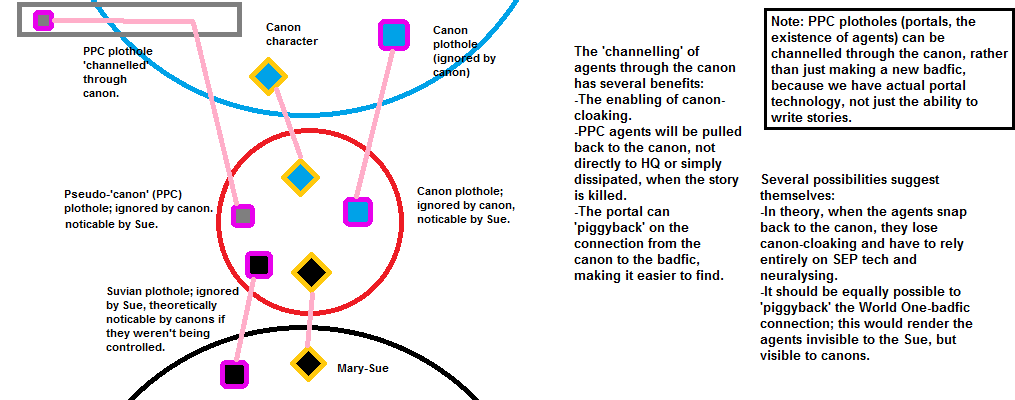Subject: Okay, I have a theory.
Author:
Posted on: 2014-07-02 12:55:00 UTC
The presentation is a bit patchworky - I was writing notes and ended up with a full theory - but I think the 'inductive reasoning' style works well for this.
Agents reach badfic via plothole
Since HQ is situated in canon, the plothole is registered by the canon as being part of itself.
Canon characters do not notice plotholes in their own works.
Therefore, canon characters do not notice agents arriving through plotholes linked to their own works.
Originally, this canon-cloaking was 'perfect'; the agents wore disguises to hide themselves from OCs only, and often didn't wear them at all.
In 1998 fanfiction.net launched, and in 2001, 'Fellowship' came out.
This combination of events led to a massive increase in the volume of fanfic.
According to ACE, badfic alters the canon it's based on.
The badfic surge destabilised the canon worlds.
As an emergency measure, agents were required to reduce plothole formation during their missions. They were ordered to a) use disguises which would plausibly kill each Mary Sue (or other sporking mechanism), and b) reduce their use of portals within the fic.
Unfortunately, the kill-centric disguises led to more strain on the canon, since agents were now asking canon characters to routinely ignore their direst enemies prancing around in front of them.
At the same time, the general destabilisation was rendering the canon less capable of distinguishing canon and uncanonical plotholes.
To battle the twofold crisis facing the PPC - PPC-created plotholes damaging the canon, and PPC agents becoming noticable to canon characters - Makes-Things modified H2G2 SEP field technology.
The original SEP required a thing to be distinctly unusual in order to render it unnoticed.
Makes-Things deduced that it would be possible to reverse this effect: rather than making canons think of unusual agents as somebody else's problem, he could make canons think of agents who fitted in as nobody's problem.
What is technically known as Nobody's Problem technology (but universally as SEP anyway) was rolled out around 2004.
Under NP protection, agents were required to wear disguises that let them blend in. If the canons thought they were normal, they would become Nobody's Problem.
The NP field also renders agent-related plotholes - portals, and random murders - Nobody's Problem as far as the canon itself is concerned.
This latter fact allowed canon-cloaking to work again, covering for the fact that agents are rather unusual regardless of their disguise - they sneak around spying on people. But canon-cloaking will hide that.
As far as OCs go: when the agents fit in with the OC's story, they are Nobody's Problem; they can hang around in the background without being noticed. But as soon as they start doing things that would be mentioned in the story if it were part of it, they become unusual. Since OCs are not part of the canon, there is no canon-cloaking effect.
Essentially, then, NP fields have zero effect on OCs (since agents who fit in silently are functionally identical to bit parts who do the same thing). With canon characters, they mask the plotholes agents create, thereby allowing canon-cloaking to augment the NP effect and make agents functionally invisible.
The essential core of that is: disguises should be as unobtrusive as possible to aid the SEP (technically NP) field. The NP works - but is fundamentally useless - against OCs. Against canon characters, it re-enables canon-cloaking, which then augments it to become effective invisibility.
I think this theory works. So where have I gone wrong and what have I missed?
hS
